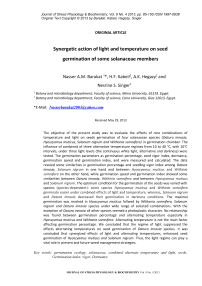Synergetic action of light and temperature on seed germination of some solanaceae members
Автор: Barakat Nasser A.M., Kabeil H.F., Hegazy A.K., Singer Nesrine S.
Журнал: Журнал стресс-физиологии и биохимии @jspb
Статья в выпуске: 4 т.9, 2013 года.
Бесплатный доступ
The objective of the present study was to evaluate the effects of nine combinations of temperature and light on seeds germination of four solanaceae species ( Datura innoxia, Hyoscyamus muticus, Solanum nigrum and Withania somnifera) in germination chamber. The influence of combined of three alternative temperature regimes from 10 to 40 °C, with 10°C intervals, under three light levels (the continuous white light, alternative and darkness) were tested. The germination parameters as germination percentage, seed vigor index, dormancy, germination speed and germination index, and were measured and calculated. The data reveled some similarities in germination percentage and seedling vigor index among Datura innoxia, Solanum nigrum in one hand and between Hyoscyamus muticus and Withinia somnifera on the other hand, while germination speed and germination index showed some similarities between Datura innoxia, Withinia somnifera and between Hyoscyamus muticus and Solanum nigrum. The optimum condition for the germination of the seeds was varied with species (species-dependent): some species Hyoscyamus muticus and Withinia somnifera germinate easier under combined effects of light and temperature, whereas, Solanum nigrum and Datura innoxia decreased their germination in darkness conditions. The maximal germination was reached in Hyoscyamus muticus follwed by Withania somnifera, Solanum nigrum and Datura innoxia species under wide range of selected combinations. With the exception of Datura innoxia all other species seemed a photoplastic character. No relationship was found between germination percentage and alternating temperature especially in Hyoscyamus muticus and Withania somnifera. Alternating temperature is not the main factor affecting germination percentage. We concluded that the regime of light suppressed the effects alternating temperatures on seed germination of Datura innoxia species. It was concluded that synergized effects of light and alternating temperatures, enhanced seed germination of Hyoscyamus muticus and Solanum nigrum. Thus, the light regime can play a vital role in present and future weed management strategies.
Germination ecology, solanaceae, combined alternate temperature and light, seeds, germination index, vigor, dormancy
Короткий адрес: https://sciup.org/14323822
IDR: 14323822
Текст научной статьи Synergetic action of light and temperature on seed germination of some solanaceae members
The temperature and light are the most important environmental factors that promote the seed germination in the soil when water is available. For most of the plants, if the light and water are available, the temperature of the soil determines the fraction of the germinated seeds and the rate of the germination (Gairola et al. , 2011). The temperature affects the germination and the state of dormancy of the seeds and the seasonal changes of the dormancy state of the seeds of some species is directly related to the seasonal temperature changes (Pons, 1993). Some species can present the seeds with the light requirement for the germination at one temperature and in another, the light insensitivity, (Smith, 1975).
Seed germination is affected by the ecological conditions prevailing in the habitat; it depends on several environmental conditions such as light, temperature, moisture germination media. It is well known that seed of certain species have different temperature responses according to variety and provenances and reasonable to believe that these responses are adaptive success or failure of a population in a particular environment depends on the way of its germination responses fit in to the ecological conditions of the habitat. Thus in most of the seeds, the rate of germination are strongly governed by temperature (Negi et al ., 1995) Germination takes place over a definite range of temperature and this range varies from species to species.
Seed germination is one of the critical phases in plant development. Each plant species has specific environmental requirements for germination (Baskin and Baskin, 1989 and Shoab et al., 2012) Temperature and light are considered the most important environment signals regulating germination, species distribution and ecological interaction Chauhan and Johson (2008).
Seed vigor means a high rate of overall biological activities of the seed. It represents the potential ability of the seed to yield the maximum plant product at the earliest time under variable environmental field conditions (Beena and Jayaram, 2010). Ecologically, these characteristics are important because it is possible to predict the degree of success of a species based on the capacity of their harvest seed to spread the germination through time, permitting the recruitment in the environment of some part of the seedlings formed (Ranal and De Santana, 2006).
Seed germination is one of the most key processes in the plant survival and growth among the stages of plant life cycles in the arid and semi arid regions of the world. (Hadas, 2004). Seed germination and early plant growth are critical stages for establishment plants under complex field condition. Temperature, play a crucial role in many biological and physiological process in plant (Al-Ahmadi and Kafi, 2007; Berti and Johnson, 2008) The alternate temperature have a major impacts on a number of processes which regulate seed germinability including membrane permeability, activity of membrane bounds as well as cytosolic enzymes (Tlig et al. , 2008). The germination of the seeds is a complex process where several reactions and individual factors are involved, every process affected by specific environmental factors (Copeland and McDonald, 1995).
Characteristics of seeds on germination present a number of highly interesting problems. Careful study of the factors controlling germination and of the complex interactions which may occur between these factors reveals many important bearings and could clarify many ecological aspects (Hammoda and Baker, 1969).
Plants regulate their germination time by having specific requirements for various environmental factors such as moisture, temperature, light and other factors (Vleeshouwers et al ., 1995). These environmental factors are not constant in time in the field and an analysis of what is actually happening with a seed in natural conditions and the possible ecological significance of a light response is very difficult to determine (Pons, 1992).Thus, germination cues reflect the climate conditions under which the species is most likely to succeed in recruitment.
According to Andrade (1995), light and temperature are the main factors that promote germination. For many plant species in arid environments, alternating temperatures may substitute the necessity of light for seed germination (Benítez-Rodrígues et al ., 2004). Pons (2000) and Probert (2000) reported that fluctuating temperatures may induce germination in the different regimes, since this fluctuation may interfere in the production of the active phytochrome form. This phytochrome is responsible for germination in light sensitive seeds (Smith, 1975). Furthermore, Takaki (2001) considered that all seeds possess phytochrome ; which is a chromoprotein pigment that reversibly inter converted by light between an inactive form (Pr) and a physiologically active form (Pfr). However, those that germinate as much in the light as in the dark present phytochrome A and those that germinate only in the light contain phytochrome B which is responsible for the photomorphogenic process (Sugahara and Takaki, 2004).
Many species respond to these environment factors with optimal growth and development according to the light they receive (Maloof et al ., 2000). Some seeds germinate similarly in light and darkness (Baskin and Baskin, 1988), while others do it more readily either under light (Colbach et al ., 2002) or darkness conditions (Thanos et al ., 1989) Also, light requirements for germination can vary with temperature. It has been demonstrated that some species need a constant temperature and light to germinate and others can germinate either under light or darkness conditions but need temperature fluctuations (Felippe, 1978). In other the high temperatures (Amritphale et al ., 1989) replace light requirements for germination.
Light-controlled germination has been associated with phytochrome since the pioneer work of Borthwick et al . (1952). Light environment plays a crucial role in seed germination specially the photosensitive seeds which allowing seeds to obtain an early signal of the actual environmental conditions. If such a signal suggests that the environment is unfavorable, then seed dormancy is induced (Taylorson and Borthwick, 1969). It also control the role of endogenous hormones, i.e., gibberellins and kinetins, which promote seed germination (Wareing et al. , 1973). Temperature regulates germination in three ways (Bewley and Black, 1994): 1) by determining the capacity and percentage of germination; 2) by eliminating primary and/or secondary dormancy; and 3) by inducing secondary dormancy. The optimal germination temperature for most seeds which are not in dormancy is 25 to 30 °C. Thus, seeds usually require a thermal periodicity to germinate.
According to Labouriau and Pacheco (1978), the effects of the temperature can be evaluated from changes in the percentage, velocity and relative frequency of germination during the incubation time. Seeds from different species require alternating of temperatures to optimize germination. This necessity most probably reflects an adaptation to natural fluctuation of the habitat or may be associated with dormancy process.
Seed dormancy is influenced by light, temperature, stratification and nitrogen containing compounds. Light signals are among the most important environmental cues regulating plant development (Franklin and Whitelam 2004).Seed dormancy aid to survival of plant species through withstanding unfavorable climatic and edaphic conditions and thus providing the plant an opportunity to germinate under favorable conditions. The timing of germination in seeds is regulated by dormancy-inducing and releasing mechanisms (Voesenek and Blom 1996). In general, these mechanisms are sensitive to environmental factors, such as light, temperature and some chemicals (Bewley 1997).
Light and temperature are two major cues through which seeds sense the proper conditions of seed germination of these four solanaceae species co-occurring in new reclaimed area of desert ecosystem (Spalding and Folta, 2005), but little is known about the integration of light and temperature information to elicit germination (Fielding et al ., 1992; Yamaguchi and Kamiya, 2000; Steckel et al ., 2004). Within this scope, the present study is an attempt towards assessing the germination response of some solanaceae members to temperature light interaction under laboratory conditions. This would contribute to know the required light and temperature conditions necessary for optimum germination of these species in soils of new reclaimed areas of Egyptian desert ecosystem.
MATERIALS AND METHODS
Seeds of four solanaceae species namely Datura innoxia Mill., Hyoscyamus muticus L., Solanum nigrum L. and Withania somnifera (L.) Dunal., were collected from natural populations in the new reclaimed field of Egyptian desert ecosystem (28’40’37 N and 30’55’25 E). Ripe seeds were sorted out for uniform size and similar external characteristics, discarding those with any malformations. Seeds were air-dried after collection, cleaned and stored at room temperature (15–20 °C, 40–60% RH) until the experiment was begun.
All seeds were surface sterilized by immersion in 2% sodium hypochlorite for 5 min, and washed afterwards with distilled water. Thereafter, Petri dishes 10 cm in diameter were prepared with two layer filter paper whatmann1 (Whatman LTD., Maidstone, England). A completely randomized experimental design with a factorial arrangement was used. Treatments consisted of nine combinations of two factors: light conditions with three subset levels (continuous light, alternative 12hr/12hr of light and dark and continuous darkness) and temperature (12/12 hours thermal period) with three subset levels (20 day/10 night, 30 day/20 night and 40 day/30 night ◦C), with 3 replications of 25 seeds and 10 ml distilled water was added for each species. These nine subsets were grouped into three sets as follow:
Set I: Alternative low temperature with various photoperiod:
(20/10 L): maximum and minimum temperature was 20/10 oC with continuous cold white fluorescent light.
(20/10 A.): maximum and minimum temperature was 20/10 oC with alternative 12 h light and 12 h darkness.
(20/10 D): maximum and minimum temperature was 20/10 oC with complete darkness.
Set II: Alternative moderate temperature with various photoperiod
(30/20 L): maximum and minimum temperature was 30/20 oC with continuous cold white fluorescent light
(30/20A): maximum and minimum temperature was 30/20 oC with alternative 12 h light and 12 h darkness
(30/20 D): maximum and minimum temperature was 30/20 oC with complete darkness.
Set III: Alternative high temperature with various photoperiod
(30/40 L): maximum and minimum temperature was 40/30 oC with continuous cold white fluorescent light.
(30/40 A): maximum and minimum temperature was 40/30 oC with continuous cold white fluorescent light.
(30/40 D): maximum and minimum temperature was 40/30 oC with complete darkness.
The time for shift from minimum to maximum temperature and vice versa was 1 hr. The range of these interactions (light-temperature) used in the experiment were selected because they are likely to be reached at the soil surface or the first few centimeters below ground in this habitat.
Germination tests were conducted in a growth chamber (Precision Dual illuminated program incubator) having four cool fluorescent tubes (32W/each) of white light and a light/darkness timer, as mentioned before to adjust the above treatments. White light was obtained with the aid of four 32W daylight fluorescent lamps. Petri dishes were inserted inside a colorless gerbox container for the experiments in light and a black gerbox container for those carried out under continuous darkness. The seeds under dark condition were monitored with a dim green safety light. Dishes were scored daily, allowed us to verify the dynamics of germination during 21 days and a seed was considered germinated when the visible radical protrusion (1mm length) as the defining criterion. Additionally, distilled water was added whenever moisture loss was detected. Treatments were ended when the germination was not observed along five consecutive days. Seed germination was evaluated by final germination percentage and vigor was expressed as germination speed index, according to the equation of Maguire (1962).
Statistical analyses
In this experiment the main factors were temperature regimes (20°/10°C, 30°/20°C and 40°/30°C), light (continuous light, darkness and alternate each 12 hours) and species. The variable responses were the proportion of germinated seed, VI, Dormancy etc.. For each time, two combined factors ANOVA were applied to test the effect of photoperiod-temperature interactions on response variable. When F tests were significant, means were compared using the Duncan’s multiple-range test (Duncan, 1955).
RESULTS
The results of this study indicated a highly significant relationship between thermal-photoperiodic interaction and plant species on germination characteristics (p≤ 0.0001). However, the germination percentage more explained by species (F-value 175.6) than treatments and their interactions (Table 1). The species germination percentages could be ranked in the following order H. muticus > W. somnifera > S. nigrum , while, D.
innoxia in the lowest rank.
For H. muticus it showed that the germination percentage was (100%) under low and moderate temperature at all photoperiodic regimes (L, A and D) except at dark condition at moderate temperature in which the germination attained minimum rate (80 %).The same trend was true in case of W. somnifera . It much interesting to show that the continuous dark decrease the germination percentage in W. somnifera to 94 % under low temperature (20/10 oC) and 84 % under moderate temperature (30/20 oC), while at high temperature (40/30 oC) increased up to 100%.
For D. innoxia at low temperature (20/10 oC) with decrease in light period from complete light (24hr) to alternative(12hr) to zero (complete darkness) the germination percentage drastically decreased from 90,68.3 to32.5% respectively. This was true under all temperature regimes with varying degrees. The same trend was observed in S. nigrum . (Fig.1). Among the different treatments it showed at low and moderate thermal regime that the temperature- photoplasticity was higher in other species compared to D. innoxia , which was more sensitive to dark (low germination rate, whatever the temperature level was). The same was true for S. nigrum and W. somnifera except at high temperature level (30 -40 D).
For seedling vigority index, all parameters significantly affecting seedling vigor index, (table 1). Among the studied species, it was appeared that the highest seedling vigor index (9.4) was registered in S. nigrum at 20-30 L, while the minimum (0.8) was found in S. nigrum at 10-20 L. D. innoxia and S. nigrum showed higher seedling vigor index in all light levels regardless of temperature level and vice versa for H. muticus and W. somnifera. For D. innoxia, the seedling vigor index showed general decrease with decreasing the photoperiod. It showed a sharp decrease with decreasing photoperiod at low temperature and slowly decreased at high temperature, while at moderate temperature the decrease in seedling vigor index as photoperiod decrease was in between. The seedling vigor index in D. innoxia and S. nigrum significantly respond to completely light at moderate, high and low temperature, respectively in contrast to that H. muticus and W. somnifera respond to completely dark at most temperature levels (Fig.2).
Dormancy was more explained by treatments (F- value 553.7 ***) than species and their interactions (table 1). The dormancy registered high percentage in all species under low temperature-completely light. In the following order 13.5, 12, 11.5 and 7 for S. nigrum ; D. innoxia ; W. somnifera and H. muticus , respectively (Fig. 3). It was observed that dormancy decreased with increasing temperature what ever the photoperiod was.
The Two-way ANOVA (Table 1) showed that species, treatment and their interactions significantly affecting germination index (P< 0.000). The germination index was more explained by species than other parameters.
Both H. muticus and S. nigrum had the highest germination index (4.2) at 20-30 A while the lowest (0.2) was observed in S. nigrum under low temperature-complete light. For D. innoxia it was observed that the germination index decreased with decreasing light period whatever the temperature regime was (20/10 or 30/20 or 40/30) For both H. muticus and S. nigrum the data observed that germination index in these two species prefer alternative light at medium and then at high temperature. W. somnifera on the other hand showed increased in germination index with increasing temperature from (20/10, 30/20, 40/30)
regardless of light period was (Fig. 4).
Species, treatments and their interactions were highly significant affecting germination speed (P< 0.001) which more explained by species ( F- 411.6 ***) than other parameters (Table 1). The germination speed of studied plant species was ranked in the following order H. muticus > S. nigrum ≥ W. somnifera and D. innoxia . It was observed that the germination speed in D. innoxia decreased as light regime decreased under all temperature regimes. From (1.13, 0.91 and 0.57) under 20/10 L, A and D, respectively. The same trend was true (2.79, 2.06 and 1.18) under 30/20L,A and D. The same trend was also true (3.82, 2.77 and 2.41) at 40/30 L, A and D reaching the minimum at dark condition whatever the temperature level was. For H. muticus the lower germination speed was observed at all continuous light under all temperature regimes (Fig. 5), the same trend was relatively very close in case of S. nigrum except under high temperature completely dark (40/30 D) However in W. somnifera germination speed showed a little increase as light period decreased under lower temperature regime, while it was showed a significant increase at medium and higher temperature regime.
The data revealed the following:
-
(1) The germination percentages in W. somnifera and H. muticus have wide ecological amplitude toward temperature and light interaction while D. innoxia has varied response and minimum germination percentage and S. nigrum was in between.
-
(2) The seedling vigor index of H. muticus and W. somnifera strongly respond to complete darkness, whatever the thermal regimes was while D. innoxia and S. nigrum respond to continuous light with varying degrees.
-
(3) The dormancy decreased with increasing temperature what ever the photoperiod was in all species
-
(4) Regarding to germination speed and germination index, much similarities was observed between D. innoxia and W. somnifera in one hand and between H. muticus and S. nigrum on the other hand.
-
(5) The germination speed decreased towards darkness under all temperature regimes especially in D. innoxia and vice versa in S. nigrum and H. muticus which showed some decrease at continuous light under all temperature levels except at higher one, while W. somnifera respond significantly to increase in all temperature levels regardless of the light period was.
Table 1. Two-way ANOVA for studied species (Sp), Temperature (Temp), light levels and their interactions. The values represent F-values at (p<0.05).
|
Parameters |
Germination percentage |
Seedling vigor index |
Dormancy |
Germination index |
Germination speed |
|
Species |
175.6*** |
58.3*** |
171.0*** |
369.779*** |
232.681*** |
|
Temperature |
18.181*** |
144.763*** |
2005.406*** |
455.825*** |
553.499*** |
|
Light |
46.841*** |
18.141*** |
100.500*** |
87.067*** |
78.374*** |
|
Sp*Temp |
28.954*** |
15.716*** |
58.406*** |
42.005*** |
27.967*** |
|
Sp*light |
49.279*** |
65.227*** |
20.250*** |
43.437*** |
29.374*** |
|
Temp*light |
21.416*** |
22.950*** |
54.375*** |
16.519*** |
35.983*** |
|
Sp*Temp*light |
20.956*** |
12.637*** |
17.062*** |
6.330*** |
10.016*** |
P<0.001 =***,p<0.01**, P<0.05 * and ns= non-significant
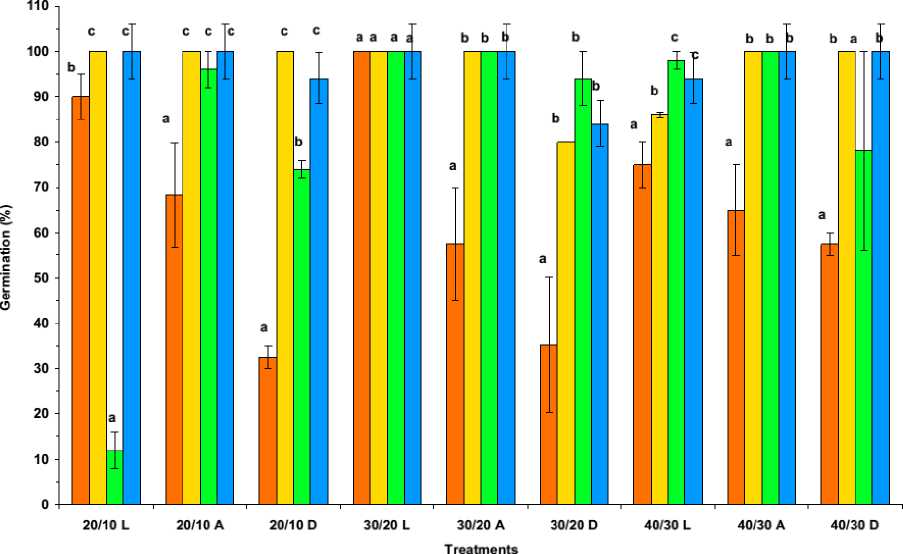
□ D. innox О H. muticus 11 S. nigrum □ И". sommeniferae
Figure 1. The germination percentage (%) of selected species under different temperature and light regimes.
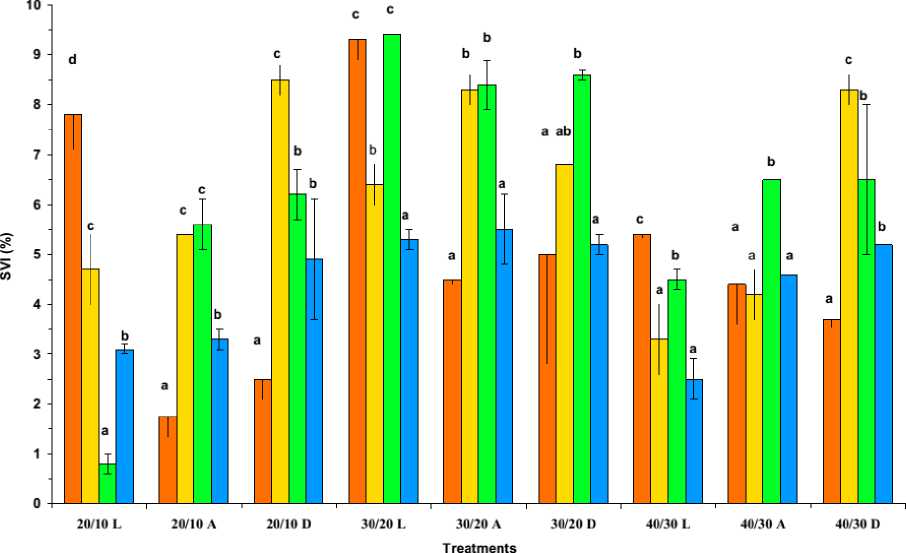
Figure 2. The seedling vigor index (%) of selected species under different temperature and light regimes.
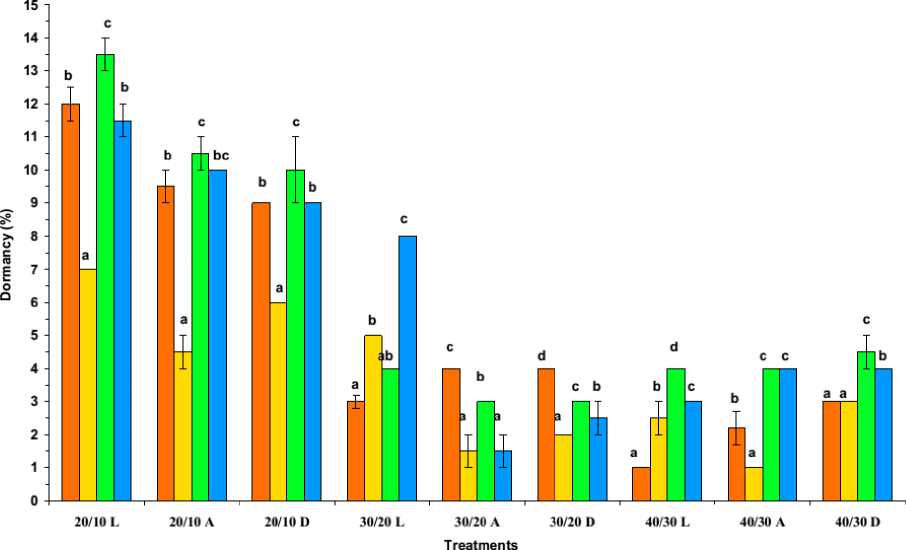
Figure 3. The dormancy (%) of selected species under different temperature and light regimes
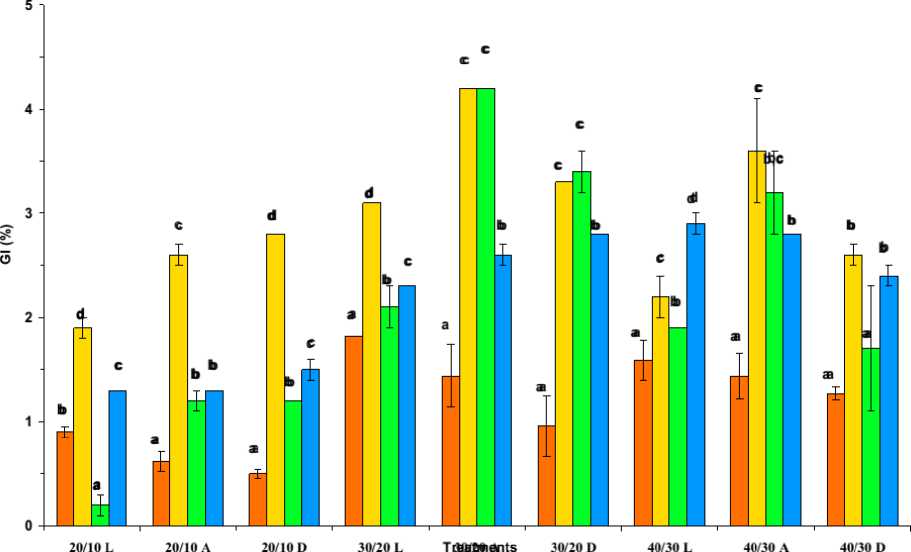
■ D.innax DH.muticus 0 V nigrum ■ Wjsommcniferac
Figure 4. The germination index (%) of selected species under different temperature and light regimes.
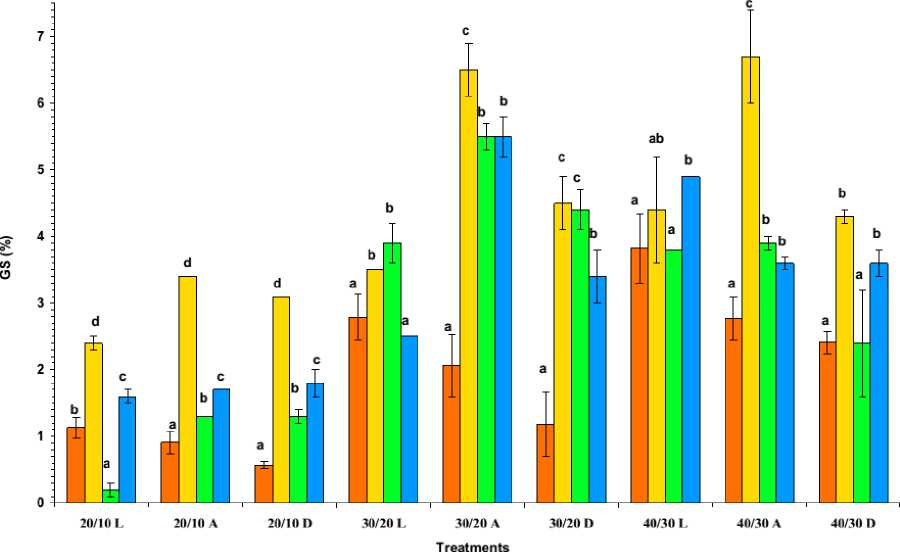
■ D.innax DH.muticus MS. nigrum Я H ’sontmeniferae
Figure 5. The germination speed (%) of selected species under different temperature and light regimes
The data on the germination percentage of the present work showed that H. muticus and W. somnifera have the high germination percentage regardless of light –temperature combinations level. This was in agreement with (Smith, 2000) on Cereus pernambucensis, who pointed out sometimes only a few milliseconds of light exposure are enough for germination to occur due to phytochrome A (Botto et al., 1996). This may explain the high germination percentages of these two species to the various levels of temperature, light and their alternations, as an adaptive mechanism for recruiting their seedlings in natural environments. They observed a photoblastic characteristics. On the other hand, the germination percentage of D. innoxia was increased with increasing temperature at darkness condition and was 32.5, 35.2 and 57.5 at 20/10, 30/20 and 40/30 oC respectively. This may be due to this temperature rage (10-40 oC ) induce certain changes in the characteristic of the seed or of the seed coat leading to easy germination. The very low germination percentage of S. nigrum (12%) under low temperature and continuous light, may be the continuous white light treatment presumably produced a steady-state phytochrome equilibrium which actually inhibited by light at low temperature. This was in agreement with (Vidaver, 1977) who suggested that this mechanism prevents germination when cool daytime temperatures.In general, the seeds of species of Solanaceae are sensitive to photoperiod, especially when the temperature varies between 20 and 30 ◦C Germination of Withania somnifera seeds was found to be both temperature and light-dependent.
Regarding the seedling vigor index this higher temperature- light regime would contribute to an increased metabolism of the embryo in the seeds, what would increase seedling vigor index (D’Antuono and Rossin, 1995; Sorlino, 2001). The decreased in seedling vigor may also be an indication of seed dormancy or it could be in response to physical changes in the seed coat that restrict germination (Thomson and Witt, 1987).
Concerning the dormancy, the result of the present work showed that dormancy decreased with increasing temperature regardless of the photoperiod in all studied species. This may be because dormancy in desert seeds could be considered as an adaptative mechanism to meet the hard conditions of the natural habitats. Dormancy due to light or heat requirements could play roles in the mechanisms of germination regulation in the desert seeds. The same also applies to dormancy due to presence of germination inhibitors in the seed or the seed coat (Hammod and Baker, 1969).
Temperature is the single most important factor regulating germination of non-dormant seeds in irrigated, annual agroecosystems at the beginning of the growth season where light, nutrients, and moisture are typically not growth limiting (Garcia-Huidobro et al ., 1982). Temperature has a dual role on dormant seeds; on one hand it regulates the seasonal changes in dormancy, and on the other hand seed germination. The temperature not only determine the germination percentage but also the germination rate. Low temperatures resulted in a low germination rate whereas high temperatures showed increased germination rate. It can be concluded that temperature has an important role in germination of weed seeds, since it both determines the range of temperatures over which germination is possible (dormancy) and is one of the limiting environmental factors during the germination process itself (Riemens et al., 2004)
Under the low temperatures the metabolic activities was relatively low and responses could not be observed in the plants (Okuzanya, 1980). On the other hand, high temperatures for long periods could induce protein denaturations. The cardinal temperatures of the seed germination reflected the conditions that led to rapid development of their seedlings (Larcher, 2000). The promotion of seed germination in investigated species may be due to gibberellins synthesis in seeds as GA biosynthesis is regulated by both light and cold temperature. The final step in active GA biosynthesis is catalyzed by gibberellic acid 3-oxidase (GA 3 ox) and importantly, the expression of both seed-expressed GA3ox isoforms is promoted by both light and cold stratification (Yamaguchi et al ., 2001, 2004).
CONCLUSIONS
Present study points some ecological strategies employed by seeds of semi desert new reclaimed region to deal with light and temperature combinations.
The result of this study might have large implications for agriculture and control of some solanaceae species. It provides part of the information, which is needed for predicting time of emergence and, thus, contribute to a more efficient weed control.
Moreover, the promotion effect of thermal-light interaction during the experiment is clearly shown in the present work. This fact verifies the thermal-photophilous nature of these investigated species.
Список литературы Synergetic action of light and temperature on seed germination of some solanaceae members
- Al-Ahmadi, M. J. and Kafi, M. (2007): Cardinal temperatures for germination of Kochai scoparia (L.) J. Arid Environ., 68: 308-314
- Amritphale, D., S. Iyengar and R.K. Sharma (1989). Effect of light and storage temperature on seed germination in Hygrophila auriculata (Schumach.) Haines. Journal of Seed Technology 13: 39-43
- Andrade, A.C.S. 1995. Efeito da luz e da temperatura na germinação de Leandra breviflora Cong., Tibouchina benthamiana Cong., Tibouchina grandifolia Cong. e Tibouchina moricandia (DC.) Baill. (Melastomataceae). Rev. Bras. Sementes 17: 29-35
- Baskin, C.C. and J.M. Baskin (1988). Germination ecophysiology of herbaceous plant species in a temperature region. American Journal of Botany 75: 286-305
- Baskin, J.M. and C.C. Baskin, (1989). Physiology of dormancy and germination in relation to seed bank ecology. Ecology of soil seed bank. San Diego, CA: Academic, pp: 53-965
- Beena K.A. and Jayaram,K.M. (2010): Effect of temperature on seed water content and viability of green pea (Pisum sativum L.) and Soybean (Glycine max L. Merr.) seeds. International journal of botany 6(2): 122-126
- Benítez-Rodrígues, J., Orozco-Segovia, A. and Rojasaréchiga, M. (2004). Light effect on seed germination of four Mammillari species from the Tehuacán-cuicatlán valley, central Mexico. Southwest. Nat. 49(1): 11-17
- Berti, M.T. and Johnson, B.L. (2008). Seed germination responses of cuphea to temperature. Ind. Crops Prod., 27: 17-21
- Bewley JD. (1997). Seed germination and dormancy. Plant Cell 9: 1055-1066
- Bewley, J.D. and M. Black (1994). Seeds: Physiology of development and germination. 2nd ed. Plenum Press, NY. 445 p
- Borthwick, H.A., Hendricks, S.B., Parker, M.W., Toole, E.H. and Toole, V.K. (1952). A reversible photoreaction controlling seed germination. Proceedings of National Academy of Sciences (USA), 38, 662-666
- Botto, J.F., Sánchez, A., Whitelam, G.C. and Casal, J.J. (1996). Phytochrome A mediates the promotion of seed germination by very low fluences of light and canopy shade light in Arabidopsis. Plant Physiol. 110(2): 439-444
- Casal, J.J. and R.A. Sánchez (1998). Phytochromes and seed germination. Seed Science and Research 8: 317-319
- Chauhan, B.S. and D.E. Johson, 2008. Germination ecology of Southern crabgrass (Digitaria ciliaris) and India crabgrass (Digitaria longiflora): Two important weeds of rice in tropics. Weed Sci., 56: 722-728
- Colbach, N., B. Chauvel, C. Dürr and G. Richard (2002). Effect of environmental conditions on Alopecurus myosuroides germination. I. Effect of temperature and light. Weed Research 42: 210-221
- Copeland, L.O. and McDonald, M.B. (1995). Principles of seed science and technology. New York: Chapman and Hall, pp. 409
- D’Antuono, L.F., Rossin, F., (1995). Experimental estimation of linseed (Linum usitatisimum L.) cropparameters. Ind. Crops Prod. 3: 261-271
- Duncan, D.B. (1955). Multiple range and multiple F tests. Biometrics 11: 1-42
- Felippe, G.M. (1978). Estudos de germinacao, crescimento e floracao de Bidens pilosa L. Revista do Museo Paulista 25: 183-217
- Fielding A, Kristie DN, Dearman P. (1992). The temperature dependence of Pfr action governs the upper temperature limit for germination in lettuce. Photochemistry and Photobiology 56: 623-627
- Franklin KA, Whitelam GC. (2004). Light signals, phytochromes and cross-talk with other environmental cues. J. Exp. Bot. 55: 271-276
- Gairola, K. C. Nautiyal, A. R.and Dwivedi, A. K.(2011). Effect of Temperatures and Germination Media on Seed Germination of Jatropha Curcas Linn. Advances In Bioresearch 2(2): 66 -71
- Garcia-Huidobro, J., Monteith JL and Squire GR (1982) Time, temperature, and germination of pearl millet (Pennisetum typhoides) Alternating temperature. Journal of Experimental Botany 33, 297-302
- Hadas, A.(2004): Seedbed preparation:The soil physical environment of germinating seeds. In: Handbook of seed physiology: Applications to Agriculture, Bench-Amold, R.L. and R.A. Sanchez (eds.) Food product press, New Yourk, pp: 3-49
- Hammouda, A.M. and Baker, Y. Z.(1969): Some Aspects of Germination of Desert Seeds. Phyton (Austria), 13: 183-201
- Kigel, J. 1995. Seed germination in arid and semi-arid regions. In Seed development and germination. Edited by J. Kigel and G. Galili. Marcel Dekker, New York. pp. 645-700
- Labouriau, L. G. and Pacheco, A. (1978) On the frequency of isothermal germination in seeds of Dolichos biflorus L. Plant and Cell Physiology, 19: 507-512
- Larcher, L. (2000). Ecofisiologia vegetal. São Carlos: RiMa, pp. 531
- Maguire J.B. (1962). Speed of germination -aid in selection and evaluation for seedling emergence vigor. Crop Science 2: 176-177
- Maloof, J.N., J.O. Borevitz, D. Weigel and J. Chory (2000). Natural variation in phytochrome signaling. Seminars in Cell and Developmental Biology 11: 523-530
- Negi, A.K., Chauhan, Shashi, Todaria, N.P. (1995). Effect of temperature on germination pattern of some trees of Garhwal Himalaya. Jr. of Tree science. 14: 11-13
- Okuzanya, O.T. (1980). Germination and growth of Celosia cristata L., under light and temperature regimes. American Journal of Botany, 67, 854-858
- Pons, T.L. (1992). Seed responses to light. In Seeds -The ecology of regeneration in plant communities.(M. Fenner, ed.). CAB International, New York, p.259-284
- Pons, T.L. (1993). Seed responses to light. In: Fenner, M. (Ed.). Seeds: The ecology of regeneration in plant communities. New York: CAB International, pp.259-284
- Pons, T.L. (2000). Seed responses to light. In Seeds: the ecology of regeneration in plant communities (M. Fenner, ed.). CABI, London, p. 237-260
- Probert, R.J. (2000). The role of temperature in the regulation of seed dormancy and germination. In Seeds: the ecology of regeneration in plant communities (M. Fenner, ed.). CABI, London, p. 261-292
- Ranal, M.A. and De Santana, D.G. (2006): How and why to measure the germination process. Revista Brasil. Bot., 29(1): 1-11
- Riemens M.M., Scheepens P.C. and van der Weide R.Y. (2004). Dormancy, germination and emergence of weed seeds, with emphasis on the influence of light: results of a literature survey Wageningen: Plant Research International. Scientific report. 40 p
- Shoab M., Tanveer, A., and Ali, H.H. (2012). Effect of Seed Size and Ecological Factors on Germination of Emex spinosa. World Applied Sciences Journal 17 (8): 964-969
- Smith, H. (1975). Phytochrome and Photomorphogenesis: an introduction to the photocontrol of plant development. London: Mc Graw Hill Company, pp. 235
- Smith, H. 2000. Phytocrome and light signal perception by plants -an emerging synthesis. Nature 407(6804): 585-591
- Sorlino, D., (2001). Efecto de la temperatura y la profundidad de siembra sobre la duración de la etapa siembra-emergencia en lino (Linum usitatissimum L.). Rev. Facultad Agronomía 21(2), 129-134
- Spalding EP, Folta KM. (2005). Illuminating topics in plant photobiology. Plant, Cell & Environment 28: 39-53
- Steckel L, Sprague C, Stoller EW, Wax L. (2004). Temperature effects on germination of nine. Amaranthus species. Weed Science 52: 217-221
- Sugahara, V.Y. and Takaki,M. (2004): Effect of light and temperature on seed germination in guava (Psidium guagava L.-Myrtaceae). Seed Sci &technol. 32, 759-764
- Takaki, M. (2001). New proposal of classification of seed based on forms of phytochrome instead of photoblastism. Rev. Bras. Fisiol. Veg. 13(1): 103-107
- Taylorson, R.B. and Borthwick, H.A., (1969). Light filtration by foliar canopies: significance for light-controlled weed seed germination. Weed Sci., 20: 417-422
- Thanos, C.A., K. Georghious and F. Skarou (1989). Glaucium flavum seed germination: An ecophysiological approach. Annals of Botany 63: 121-130
- Thomson, C,E. and Witt, W.W. (1987): Germination Of Cutleaf Groundcherry (Pbysalis Angulata), Smooth Groundcherry (Pbysalis Virginiana), And Eastern Black Nightshade (Solanum Ptycanthum). Weed Science. 35: 58-62
- Tlig, T., Gorai, M. and Neffati, M. (2008): Germination responses of Diplotaxis harra to temperature and salinity. Flora, 203: 421-428
- Vidaver W. (1977). Light and seed germination. In AA Khan, ed, Physiology and Biochemistry of Seed Dormancy and Germination. North Holland Publ Co,& Amsterdam, pp 181-192
- Vleeshouwers L.M., Bouwmeester H.J. and Karssen C.M. (1995). Redefining seed dormancy: an attempt to integrate physiology and ecology. J. Ecol. 83: 1031-1037
- Voesenek J.A.C.J., Blom C.W.P.M. (1996). Plants and hormones: an ecophysiological view on timing and plasticity. J. Ecol. 84: 111-119
- Wareing, P.F., J. Van Staden, and D.P. Webb. (1973). Endogenous hormones in the control of seed dormancy. Pages 145-155 in W. Heydecker ed. Seed Ecology. Pennsylvania State Univ. Press, University Park
- Yamaguchi S, Kamiya Y, Sun T. (2001). Distinct cell specific expression patterns of early and late gibberellin biosynthetic genes during Arabidopsis seed germination. Plant J. 28: 443-453
- Yamaguchi S, Kamiya Y. (2000). Gibberellin biosynthesis: Its regulation by endogenous and environmental signals. Plant Cell Physiology 41: 251-257
- Yamauchi Y, Ogawa M, Kuwahara A, Hanada A, Kamiya Y, Yamaguchi S. (2004). Activation of gibberellin biosynthesis and response pathways by low temperature during imbibition of Arabidopsis thaliana seeds. Plant Cell 16: 367-378

